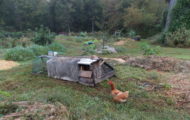I’ve been writing a lot about our starplate pasture, but realized I hadn’t regaled you with an update on our more established series of forest pastures in quite some time. There’s a lot to say, so in this post I’m going to stick to the trees.
One of my experiments has involved adding American persimmons
to three pastures, with the plan of eventually grafting Asian
persimmons onto those native rootstocks to keep the trees small, to
promote early bearing, and to negate the need for separate male and
female trees. Due to a really cold winter, though, that plan is
looking like less of a good idea.
Why? Because the
Saijo (Asian) persimmon I planted in fall 2011 died back to the ground
before it ever got old enough to bear fruit. True, the tree
(pictured to the left) is sprouting back from the base, but I’m pretty
sure what I’m seeing is just rootstock growth. If one of the most
hardy Asian persimmon varieties isn’t truly hardy in our climate, it
doesn’t make sense to replicate any type of Asian persimmon throughout
our pasture.
How are the seedling
American persimmons doing? Like the Asian persimmon, some died
back to the base last winter, but most seem to have survived the winter
unscathed (top photo). Now I’m wondering if careful training could
promote dwarfing in these American persimmons so they fit in their
small pastures without shading out the nearby garden. I’m not sure
if I really want to wait a decade or two for fruit, though….
Another tree experiment
from the same era involved mulberries. This tree trial shows much
more promise, although some of my hearsay or book-learning knowledge has
turned out to be not so hot.
I’ll start with the pros
— despite losing a few small branches to the cold, our Illinois
everbearing mulberry is thriving and is loaded with fruit this
year! Unfortunately, the two other varieties I planted in our
blueberry patch to expand our selection didn’t fare as well. The
Oscar’s mulberry died back to the base but seems to be resprouting
(above the graft union, I think), but the Silk Hope is fully dead.
Again, pushing the hardiness zone envelope seems not to be called for
due to recent weather extremes.
What else would I do differently in the future? I had read that mulberries fruit on first-year wood, so you can pollard
half of the tree each year and get a good crop on one-year wood. I
forgot to pollard this spring, though, so I currently have a tree with
two-year wood and one-year wood…which is handy since that old-wive’s
tale seems to be wrong. The two-year-old half of the tree is
covered in berries while the one-year-old half has…none. Now I’m
thinking that training the tree is a better way of keeping the size
down so that I can reach the berries, or I might just let the tree grow
and pick fruits from near the base while letting the chickens get the
rest. Unlike the persimmons, this tree is a good distance from the
vegetable garden and won’t do any harm if it achieves the estimated
spread of 20 to 30 feet.
Since Illinois
everbearing mulberries grow fast, survive the winter, and fruit
prolifically, I’ll probably continue my propagation experiments despite
the pollarding failure. Last year, I discovered that mulberries don’t root easily from hardwood cuttings,
so I’ll collect some fruits this summer and instead try growing them
from seed. The jury’s out on whether I’ll graft Illinois
everbearing twigs onto the seedlings in a year or two or whether I’ll
just see if the seedlings produce good fruits. Stay tuned for more
forest pasture experiments to come!

